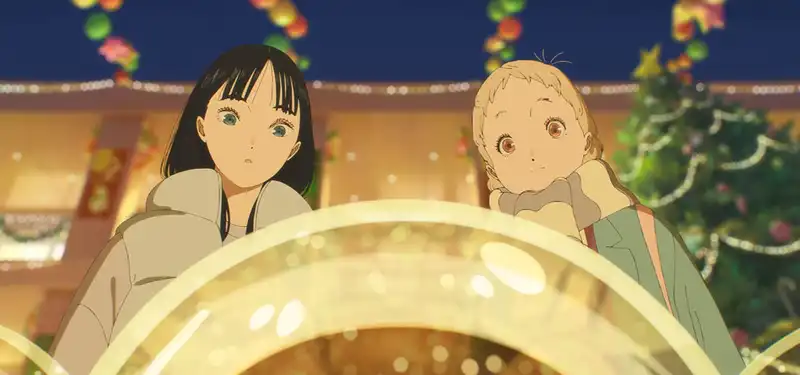Nov 12, 2024
"Sometimes we can't see ourselves as ourselves": Why director Naoko Yamada made "Colors in the inside"
Among Japanese feature-length animation directors, Naoko Yamada is in many ways a unique figure. Not only has she been able to build a career as a female director in a male-led environment, she has worked with prominent studios over the years and is often in charge of storyboards and music for her own films.Start from K-ON. After working in Kyoto Animation as a unit director after the disappearance of Haruhi Suzumiya in 2009 1 year after the anime series, he directed titles such as "Liz and The Blue Bird, A Silent Voice" and "Heike Monogatari", both series and feature films, and created his first collaboration with Science Saru, the studio behind his latest work. "I'm not going to let you down," he said.
Yamada's bond with the art of sound and melodies, as a music lover, was less pronounced than Colors Within, which premiered in North America last month with Animation Is Film. The FILM is expected to be released in the US through GKIDS in 2025/1/24.
The film follows Totsuko, a teenage girl struggling with self-doubt and a sense of being lost in the world while dealing with synesthesia. Her journey is depicted in vibrant, symbolic colors, representing her emotional state and inner world. Throughout the story, she is seen connecting with herself and others, trying to find her real voice with the help of Kimi and Louis.
The director has already revealed that music and sound play a strong role in her films, but the colors inside take the bond between animation, music and, in truth, life to another dimension of Yamada's career. Comic Brew talked with Yamada about her latest film, animation as a medium, and the art of sharing drawings, sounds and colors and emotions.
Cartoon Brewing: How the Colors in Fit in your illustrious career so far and something new you especially wanted to do with this movie In this 1 one, I took everything I've learned so far and tried to take advantage of it to deliver the best story. The latest films are, of course, always on my head, but what I wanted to show in this film is how people communicate with each other, which is all of Totsuko's character. For me, everyone has a kind of sense when it comes to communication, but the colors that Totsuko sees, if we look long enough, look beyond appearance
Music plays a big role in understanding characters and communication with each other. How did you work with composer Kensuke Ushio to convey these feelings -
For me, it was important that these songs – songs that children create within the band – should not sound like adult music. I had to believe that this music was really created by the three characters Totsuko, Kimi and Louis, with their skills and musical knowledge. I wanted to show all these characters as individuals with their own challenges, complexity and honesty, especially children. I grew up mentally as I got older, but I still respect young people, and I think it's important to try to talk to everyone equally and respect everyone's dignity. I didn't want to show adults as characters who were just trying to get in the way of things, and young people didn't want to show them as people who were just doing what they wanted to do. I wanted to portray all the characters as human beings, their flaws and vulnerabilities, to reassure my teens that it was okay to be completely myself.
The colors inshowcase different styles and animation techniques. Talk a little about your visual approach to cinema.
What I really wanted was for the audience to understand and be able to share the way Totsuko sees and feels the world. So, I was working on those sections of the film until I got to where it would be represented, but at the same time I wouldn't lose the audience's track. It was a balance to find between Tostruko's imagination and the real world surrounding those characters.
What was the biggest challenge during this production -
For me, writing and drawing storyboards is always the hardest part. This was especially true in this case, because the film is an original story. I knew I had to make something that no one had ever seen, and it was exciting and nerve-wracking at the same time. In this film, obviously finding the balance between the 2 worlds was also a challenge, but developing them with the team was also very fun. I am very proud of the series of trial and error that led to this result.
If you were in the world of Totsuko, what would your colors be-
I find it the hardest question to answer. I would say I don't know myself well, because when I see the world, I see everyone else. So I wouldn't be able to answer that question right now. What I know is that as a teenager, if you don't fit in the box, or you can't get into the category you want to be, it's you or maybe you're rejecting yourself, it leads to negative emotions. And that was the whole idea behind this film, not only a Japanese topic, but also a very universal one. Sometimes I don't think I am myself, and it's great to find someone who can show me the positive side of myself, and that's one of the reasons I wanted to make this film.
Last question and big question: What is animation for you as a medium -
I feel like I've been making animation for a long time, so I take it for granted. But I think you just reminded me of the miracle that I can actually make an animation and I'm really grateful for it. To me, I just say that animation is life.
.



Post your comment